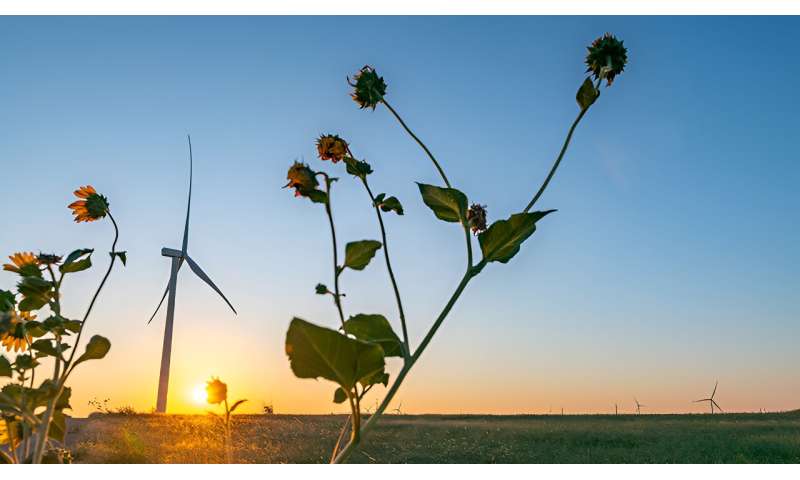New wind resource database includes the updated WIND toolkit

They say you do not need a weather forecaster to know which way the wind blows.
If you are planning to install a wind turbine or wind farm, there is more to it than that. You also need to understand where the wind blows—such as ideal landscapes for strong, consistent winds. And you will need information about the atmospheric forces that affect how wind turbines perform and how much energy they capture.
Fortunately, the National Renewable Energy Laboratory's (NREL's) new Wind Resource Database can help. Developed to support the transition to a clean, secure, and affordable energy future, the database hosts high-resolution temporal (time-based) and spatial (location-based) datasets developed using simulations that are widely used across academia, laboratories, and industry.
"First and foremost, the Wind Resource Database provides the data to determine where a good site for installing wind turbines or building wind farms would be," said NREL wind researcher Caroline Draxl, who helped develop the database.
"With interactive maps and a simplified data retrieval process, this database provides a user-friendly experience for everyone—from wind energy developers and wind integration folks to people who just want to know about available wind resources."
Big data, easy access
The Wind Resource Database offers open access to more than a petabyte of detailed wind resource data covering the United States and several other countries. That volume of data is the same as about 250 million MP3 songs—to which you could listen nonstop for thousands of years without hearing the same song twice.
"A petabyte is a large amount of data, and one of the reasons why the database is so large is because it includes many years' worth of data at a very fine spatial and temporal resolution—such as five-minute wind speed data at multiple wind turbine hub heights," said Nicholas Gilroy, an NREL software development group manager who led the development of the Wind Resource Database. "The platform has vast coverage across the contiguous United States, select offshore regions, Alaska, Hawaii, Puerto Rico, Canada, Mexico, Southeast Asia, and Ukraine."
The Wind Resource Database is a web-based update to NREL's former Wind Prospector, which provided NREL wind resource and model data for analyzing wind energy potential.
"The Wind Resource Database is a similar concept but applies user experience research to engage with previous users of the Wind Prospector," Gilroy said. "This helped us to identify the target audience and reprioritize the needed functionality of the platform to better meet those users' needs."
Users can visualize the data and download it for offline use. If a user is interested in one location, there is an efficient way to grab a single point of data without having to comb through a petabyte of data. Or, if someone only wants specific attributes, but across a vast area, the platform can also efficiently grab those data.
Key database features
An expandable, web-based platform, the Wind Resource Database provides easy access to the following:
- More than one petabyte of high-value wind resource data
- Datasets at five-minute, 2-kilometer (km) resolution for various regions across the globe (newly modeled for the contiguous United States, Alaska, and Hawaii as part of the WIND Toolkit Long-term Ensemble Dataset)
- Aggregated wind energy statistics
- Meteorological information that is valuable for wind energy applications, including distributed and utility-scale wind energy, airborne wind energy, grid integration, power systems analysis, and environmental analysis
- All current and, over time, future NREL wind datasets.
"Developing a platform that can deal with big data like this is not easy," Draxl said. "We created the backend of the platform—the system running in the background that does the work—in a way that supports the latest security requirements and helps with maintenance down the road."
As the data are based on computer models and therefore contain built-in uncertainty, Draxl recommends that users supplement the data with real-world wind and/or other meteorological observations in the kind of terrain or at the specific location of interest.
WTK-LED
A primary feature of the Wind Resource Database is an update to the Wind Integration National Dataset Toolkit (WIND Toolkit) called WTK-LED: The WIND Toolkit Long-term Ensemble Dataset.
A weather-related dataset, WTK-LED provides users with a range of possible wind speeds made available at five-minute intervals every 2 km across the contiguous United States, Alaska, and Hawaii. WTK-LED includes:
- Data at multiple vertical planes above ground level in the region of the atmosphere where wind turbines operate, enabling accurate modeling of the winds blowing across utility-scale and distributed wind turbines
- High-resolution five-minute, 2-km data for 2018, 2019, and 2020 for the contiguous United States and Alaska
- Model uncertainty of wind speed at every modeling grid point to provide users with a range of possible wind speeds every 2 km
- A separate long-term dataset, the 2023 National Offshore Wind dataset (NOW-23), tailored specifically to offshore wind resource assessments for the Atlantic Coast, Great Lakes, Hawaii, Pacific Coast, and Gulf of Mexico.
"With the creation of WTK-LED, we offer the community an up-to-date, long-term dataset tailored to wind energy applications," Draxl said. "Uncertainty estimates, which help users understand the limitations of the new dataset, are also included."
"The Wind Resource Database has big implications in terms of our international reach," Gilroy said. "With lots of international datasets, the platform could help developing countries determine what their renewable energy deployment potential looks like."
Publicly available at no cost, data within the Wind Resource Database can be accessed via the WRDB Viewer Application.
Provided by National Renewable Energy Laboratory